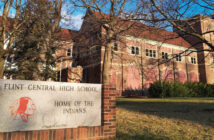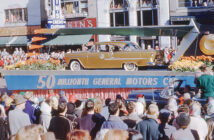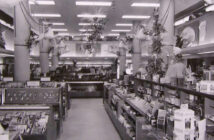James H. Whiting was born in Torrington, CT in 1842. He served in the 23rd Connecticut Infantry during the Civil War and afterwards made his way to Flint. In 1882, he became manager of the Begole, Fox & Company lumber mills, whose anemic outputs resulted from the severe depletion of timber surrounding the town. Whiting was charged with converting the firm from a processor of raw material into a manufacturer of finished wooden products, enabling the company to survive the death of the lumber industry. Whiting rose to the challenge, establishing the town’s first incorproated business, The Flint Wagon Works, that same year. Some years earlier, William Paterson had begun producing high quality carriages, and while the Flint Wagon Works began by manufacturing farm wagons, wheels and axles, it would eventually enter the carriage business as a competitor to Paterson; both would be surpassed in that venture by the Durant-Dort Carriage Co.
At the turn of the century, when David Dunbar Buick was experimenting with engine design in Detroit with nary a thought of Flint in his head, a few forward-looking citizens of the Vehicle City were thinking seriously of horseless carriages. One of these men was A.B.C. Hardy, who left the Durant-Dort Carriage Company in 1901 to begin producing the Hardy Flint Roadster. The other was James Whiting. Given his age – 61 – and his business disposition – conservative – his interest is surprising, especially given the scorn of the other carriage manufacturers in town. To them, automobiles were noisy, smelly and dangerous contraptions, annoying to people and horses. Whiting, on the other hand, had been intrigued by the automobile since prototypes first began appearing outside of carriage conventions, and it was said that he often visited A.B.C. at his tiny automobile factory during the two years that Hardy built cars. Terry Dunham and Lawrence Gustin, authors of The Buick: A Complete History, say that Whiting and Hardy realized something that Durant, Dort and Paterson refused to accept at first: that their industry was transient, just like the lumber industry years ago. “Whiting accepted Hardy’s theory that the horseless carriage would eventually make the horse-drawn variety obsolete,” the researchers claim. “If Flint in general, and the Flint Wagon Works in particular, were to prosper, this was surely a new field to carefully consider.”
On 11 September 1903, Whiting announced that the Flint Wagon Works had bought the Buick Company in Detroit in order to produce engines; but when asked if he would produce an automobile, Whiting avoided the question. Historians surmise that automobile manufacture was Whiting’s intention all along, but securing funding for a dubious venture of that magnitude was nearly impossible at the time. The Wagon Works’ directors had a reputation for judiciousness, and that combined with their stated intention to produce engines secured them a loan from the Union Trust & Savings Bank of Flint. The Flint Journal dated from the day of Whiting’s announcement corroborates the general consensus: “The announcement that this new enterprise is in the hands of such successful, conservative and prudent businessmen as the stockholders of the Flint Wagon Works is… a guarantee to the people of Flint that an industry of importance has been added to the manufacturing interests of the town…”
The return of Walter Lorenzo Marr to the Buick Motor Co., now headquartered in Flint as per the recent 1904 incorporation papers, is what finally pushed Whiting into the automobile market. Upon hearing about Marr’s termination from yet another company, Buick wrote a warm letter to his twice-former employee, requesting that Marr visit or phone him if he had not yet found other employment. Marr cautiously agreed to work for David for what would be the third and final time, but he added a caveat: each man must allow for the other’s temper. This agreement appears to have been just what they needed, as Marr worked for Buick Motor until his retirement. Other employees of the new Buick were Arthur C. Mason from Cadillac, Thomas Clint, the machine shop foreman, and William Beacraft.
The first Flint Buick was seen chugging along Kearsley Street in front of the factory in July of 1904. With David’s son Thomas, Walter drove the two-cylinder car to Detroit to buy a license. Plastered with mud from head to toe, Marr and Buick returned ecstatic, and Whiting gave the order to commence production. Albert B. Calver, an assembler at the Flint Wagon Works, remembered in 1953 how unorganized production was in the early days of Buick: “They gave us some blueprints to go by, but a lot of the design had to be made up as we went along. Whenever we got stuck we just did things the way we had done with the buggies … and none of the bolts we used were cut to size. We just went around to the barrel and hunted around for bolts we thought might fit.” Despite the lack of precision, historians agree that 37 Buick Model Bs were built in 1904 in total, not a very impressive number.
Whiting was not pleased. Dunham and Gustin record that “the elderly businessman was instead deeply worried.” Putting the Buick into production had exhausted all of the Wagon Works’ capital and then some: $25,000 dollars each from three Flint banks in addition to the original $37,500 borrowed from the Union & Trust Savings Bank. Whiting needed a financial angel, and a salesman.
The rest, as they say, is history. Whiting succeeded in enticing Billy Durant to take over Buick, and almost immediately the company began its explosive growth. But what of the men who built the foundation? What of Buick himself? Next month, we’ll conclude with a synopsis of the fates of the shadow men of Buick.







